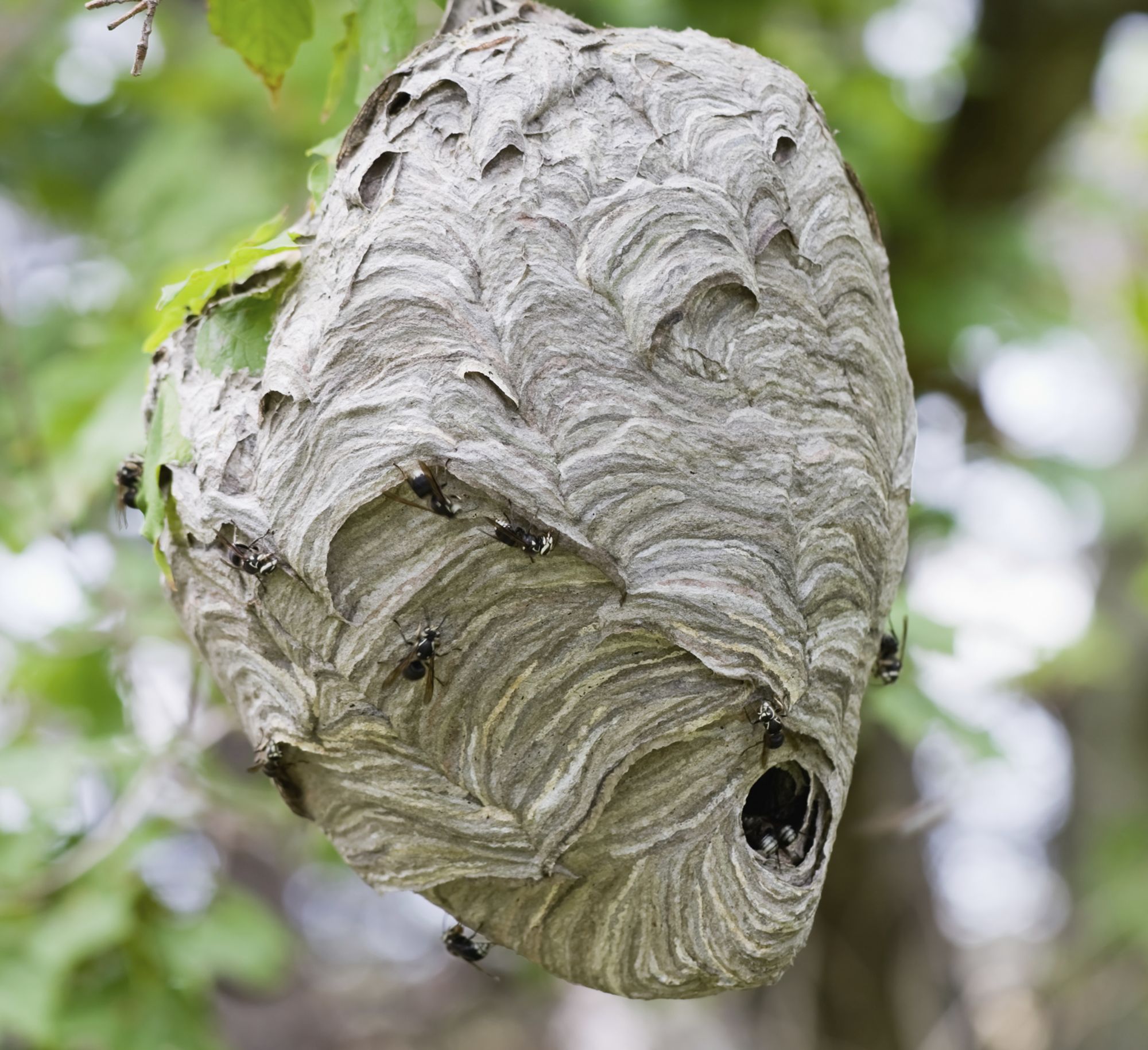How far do bald-faced hornets fly? Bald-faced hornets commonly travel up to 1,000 feet (around 300 meters) from their nest while foraging for food. However, this distance can vary depending on factors such as food availability, colony size, and the surrounding environment. This article will explore the bald-faced hornet foraging range and other aspects of their habitat and behavior.
Image Source: images.terro.com
Getting Acquainted with Bald-faced Hornets
Bald-faced hornets (Dolicovespula maculata) are fascinating creatures, but they can also be intimidating if you encounter them unexpectedly. Before diving into their travel habits, let’s get to know them a bit better.
Identifying a Bald-faced Hornet
Bald-faced hornets aren’t actually hornets; they are a type of yellowjacket. Despite the name, these insects are primarily black and white, not bald. The “bald-faced” part comes from the white markings on their face. Here are some key features:
- Color: Predominantly black with white or pale yellow markings on the face, thorax, and abdomen.
- Size: Workers typically range from 1/2 to 3/4 inch (1.3 to 1.9 cm) in length, while queens can be larger.
- Shape: They have a characteristic wasp-like shape, with a narrow waist between the thorax and abdomen.
Habitat Preferences
Bald-faced hornets are native to North America. They thrive in various environments, including:
- Forests and Woodlands: They often build their nests in trees and shrubs.
- Suburban Areas: They can be found in yards, parks, and gardens.
- Urban Environments: Sometimes, they may nest on buildings or other structures.
Nesting Habits
Bald-faced hornets are known for their large, paper-like nests. Key facts about their nests:
- Construction: Nests are made from chewed wood pulp mixed with saliva.
- Appearance: They are usually gray or brown and can be quite large, sometimes reaching the size of a basketball or larger.
- Location: They typically build nests in trees, shrubs, or under eaves of buildings.
Decoding the Bald-faced Hornet Foraging Range
Understanding the bald-faced hornet foraging range is crucial for managing potential encounters and avoiding stings. Several factors influence how far these insects travel from their nests.
Factors Influencing Bald-faced Hornet Travel Distance
Several things affect how far bald-faced hornets travel:
- Food Availability: If food sources are scarce near the nest, they’ll fly farther.
- Colony Size: Larger colonies need more food, causing workers to travel longer distances.
- Environment: Open areas may require longer flights than dense forests.
- Weather: Extreme weather can limit foraging.
- Nest Age: Older nests have more workers, increasing the foraging area.
Typical Bald-faced Hornet Foraging Distance
The bald-faced hornet travel distance is generally within a specific range:
- Average Distance: Most studies and observations suggest that bald-faced hornets typically forage within a radius of up to 1,000 feet (300 meters) from their nest.
- Maximum Distance: In some cases, they may travel up to a mile (1.6 kilometers) in search of food, although this is less common.
Research on Hornet Flight Range From Nest
While precise tracking of individual hornets is challenging, studies and observations have helped estimate their flight ranges:
- Mark and Recapture Studies: Researchers mark hornets and track where they are recaptured.
- Observation: Watching how hornets behave and their foraging patterns.
These studies help define the bald-faced hornet habitat area and how they utilize it.
How Far Do Hornets Fly for Food?
Bald-faced hornets are predators and scavengers. They feed on:
- Insects: They hunt flies, caterpillars, and other insects to feed their larvae.
- Nectar: Adult hornets feed on nectar from flowers.
- Sugary Substances: They are attracted to honeydew, fruit juices, and other sweet substances.
The need for these resources dictates how far they’ll fly.
Bald-faced Hornet Territory Size: What It Means
The bald-faced hornet territory size represents the area a colony uses to find food and resources. Several aspects define this territory.
Defining Hornet Colony Territory
- Resource Needs: A larger colony needs a larger territory to support its growth.
- Competition: Competition from other insect colonies can shrink the territory.
- Environmental Constraints: Natural barriers like rivers or mountains can limit the territory size.
Bald-faced Hornet Nest Proximity and Territory Overlap
How close hornet nests are to each other affects how they use their territory.
- Nest Density: In areas with many nests, the territories may overlap, leading to competition.
- Spacing: Hornets prefer to space their nests to reduce conflict.
- Resource Partitioning: Different colonies might focus on different food sources to avoid direct competition.
Defending Their Territory
Bald-faced hornets are very protective of their nest and territory.
- Aggressive Behavior: They will aggressively defend their nest against perceived threats.
- Stinging: They can sting repeatedly, making them a dangerous nuisance.
- Alarm Pheromones: When threatened, they release chemicals that attract other hornets to help defend the nest.
Hornet Foraging Behavior: A Closer Look
Studying the hornet foraging behavior reveals valuable insights into their activities and how they interact with their surroundings.
Daily Foraging Patterns
- Time of Day: Hornets are most active during daylight hours, especially in warm weather.
- Weather Influence: They avoid foraging in heavy rain or strong winds.
- Seasonal Changes: Their activity peaks in late summer and early fall when colonies are largest.
Communication and Coordination
Hornets communicate to find food and resources.
- Pheromones: They use chemical signals to mark food sources and alert others to danger.
- Visual Cues: They also use visual signals to communicate within the colony.
- Division of Labor: Different workers may specialize in certain tasks, such as hunting or nest building.
Adapting to the Environment
Hornets are adaptable creatures.
- Dietary Flexibility: They can adjust their diet based on available food sources.
- Nest Site Selection: They can build nests in various locations, depending on habitat availability.
- Learning: They can learn and remember the locations of reliable food sources.
Safety Tips: How to Avoid Encounters
Knowing how far bald-faced hornets travel can help you reduce the chance of being stung.
Minimizing Risk
- Awareness: Be aware of your surroundings, especially in areas where hornets are common.
- Avoidance: Stay away from nests if you spot them.
- Protective Clothing: If you need to work near a nest, wear protective clothing.
What to Do If You Encounter a Nest
- Do Not Disturb: Do not disturb or approach the nest.
- Slowly Retreat: Slowly move away from the area.
- Alert Others: Warn others about the nest’s location.
Professional Help
- When to Call: If a nest is near your home or poses a threat, contact a professional pest control service.
- Removal: Professionals have the tools and knowledge to safely remove the nest.
- Safety: Never try to remove a nest yourself, as this can be dangerous.
Comparing Bald-faced Hornets to Other Hornets and Wasps
It’s helpful to see how bald-faced hornets compare to other related species.
Size and Appearance
| Feature | Bald-faced Hornet | European Hornet | Yellowjacket |
|---|---|---|---|
| Size | 1/2 – 3/4 inch | 1 – 1.5 inches | 1/2 inch |
| Color | Black with white markings | Brown and yellow markings | Black and yellow stripes |
| Nest Location | Trees, shrubs, buildings | Trees, hollow structures | Ground, walls |
| Aggressiveness | Highly aggressive | Moderately aggressive | Aggressive |
Foraging Habits
| Species | Typical Foraging Distance | Preferred Food Sources |
|---|---|---|
| Bald-faced Hornet | Up to 1,000 feet | Insects, nectar, sugary liquids |
| European Hornet | Up to 1 mile | Insects, fruit, tree sap |
| Common Yellowjacket | Up to 500 feet | Insects, meat, sweets |
Nesting Behavior
| Species | Nest Material | Nest Size | Nest Location |
|---|---|---|---|
| Bald-faced Hornet | Chewed wood pulp | Basketball-sized or larger | Trees, shrubs, buildings |
| European Hornet | Decayed wood | Large, up to 3 feet | Trees, hollow walls, attics |
| Common Yellowjacket | Paper-like material | Small to medium | Underground, walls, rock piles |
The Impact on Ecosystems
Hornets play a vital role in their environments.
Beneficial Roles
- Pest Control: They prey on insects, helping control pest populations.
- Pollination: They visit flowers for nectar, aiding in pollination.
Potential Problems
- Stings: Their stings can be painful and dangerous, especially for those with allergies.
- Damage: They can damage fruit crops and disturb outdoor activities.
Observing Changes
Watching for changes in hornet behavior can provide important information.
Climate Change
- Range Shifts: Warmer temperatures could cause them to expand their range.
- Activity Changes: Altered weather patterns could affect their foraging habits.
Habitat Loss
- Nest Site Scarcity: Loss of trees and shrubs could limit nesting sites.
- Food Source Depletion: Habitat destruction could reduce the availability of prey insects and nectar sources.
Human Influence
- Urbanization: Urban sprawl can create new nesting opportunities and food sources.
- Pesticide Use: Pesticides can harm hornet populations and disrupt their role in the ecosystem.
Conclusion: Living Alongside Bald-faced Hornets
Bald-faced hornets can travel up to 1,000 feet from their nest to find food. They are a key part of their ecosystem, acting as predators and pollinators. By understanding their behavior and habits, we can reduce the risk of stings and coexist peacefully.
Frequently Asked Questions (FAQ)
What is the average bald-faced hornet foraging range?
The average bald-faced hornet foraging range is up to 1,000 feet (300 meters) from their nest.
How far do hornets fly at most?
In some cases, bald-faced hornets may fly up to a mile (1.6 kilometers), but this is less common.
Can I remove a bald-faced hornet nest myself?
It is not recommended to remove a bald-faced hornet nest yourself, as they are very aggressive and can sting repeatedly. Contact a professional pest control service.
What is the bald-faced hornet territory size?
The bald-faced hornet territory size depends on the colony size, food availability, and competition from other insect colonies.
Why are bald-faced hornets considered beneficial?
They are considered beneficial because they prey on insects, helping control pest populations, and they also aid in pollination.
Are bald-faced hornets dangerous?
Yes, bald-faced hornets can be dangerous due to their aggressive behavior and ability to sting repeatedly. Their stings can be painful and can cause allergic reactions in some individuals.
What should I do if I get stung by a bald-faced hornet?
If you get stung, wash the area with soap and water. Apply a cold compress to reduce swelling. If you experience severe symptoms such as difficulty breathing or swelling of the throat, seek immediate medical attention.
Do bald-faced hornets return to the same nest every year?
No, bald-faced hornet nests are not reused. The colony dies off in the winter, and a new queen starts a new nest in the spring.

Hi, I’m Candace Wafford, a travel and food blogger based in Lexington, Kentucky. As a corporate traveler, I’ve had the chance to explore a lot of places, but now I’m on a mission to travel full-time. My goal? To figure out how to take my cat along for the adventure! Here at destinationdorworth.com, I share my experiences and tips on outdoor activities, travel, and of course, the best food spots I come across. I hope my blog inspires you to explore more and eat well on your journeys!

